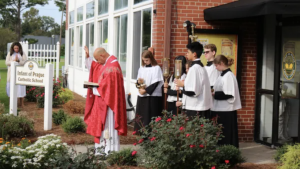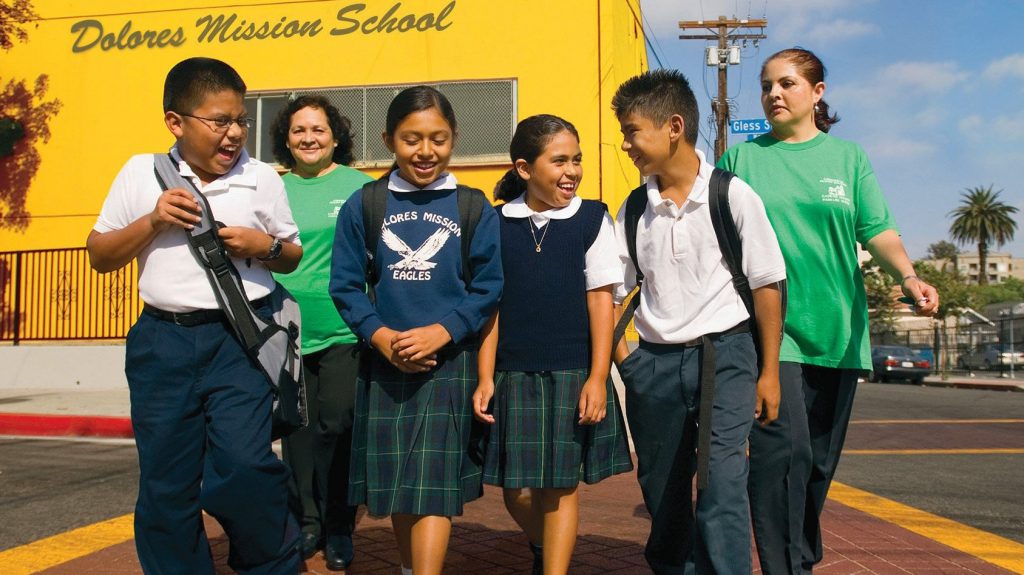An EWTN News/RealClear Opinion Research poll of Catholic voters suggests that dissatisfaction with several aspects of public education may help explain why Catholic schools are enjoying an increase in enrollment nationwide.
The poll found that 74% of Catholic voters are concerned about children suffering from an educational “COVID deficit” caused by the shift to online learning during the pandemic. Seventeen percent said they were not concerned and 10% said they were not sure.
EWTN’s polling also revealed concerns among Catholics about the quality and content of education at public schools. Nearly 47% of respondents with children in public school said they have considered, in the past year, moving their children from a public school to a private or parochial school because of concerns about the quality of the education received.
A majority of Catholic voters also support parents of K–12 students helping determine what is being taught in schools (64%), oppose biological boys who identify as girls competing against biological girls on school sports teams (76%), and oppose introducing Critical Race Theory (CRT) into the classroom (60%).
The poll, conducted by the Trafalgar Group Sept. 12–19, surveyed 1,581 Catholic voters and has a margin of error of 2.5%. The questionnaire was administered using a mix of six methods, including live phone calls, text messages, and email.
The poll’s results point to several possible explanations for the recent uptick in Catholic school enrollment. Several educators CNA spoke with cited Catholic schools’ emphasis on a quick return to in-person learning during the COVID shutdown, the high quality and Christ-centeredness of the education provided, and an emphasis on partnering with parents in the education of their children as contributing factors in parents’ decisions to switch from public schools since the pandemic.
The COVID effect
Enrollment dropped sharply in the early stages of the COVID-19 pandemic, falling 6.4% from 2019-2020 to 2020-2021, according to the National Catholic Educational Association (NCEA). That was the largest decline in the 50 years since the NCEA started collecting enrollment data.
The numbers rebounded in the 2021-2022 school year, reaching record levels in some dioceses.
Nationwide, Catholic enrollment jumped from 1.63 million to 1.69 million, an increase of more than 3.5%, the NCEA reported.
Though the statistics show that enrollment has not yet reached pre-pandemic levels — 1.74 million students enrolled in 2019 — the reversal is notable, as before the pandemic enrollment was trending down by 2% to 3% annually.
Several of the 10 largest dioceses for Catholic school enrollment registered increases of between 1.22% and 5.37% in 2021-22.
Catholic schools, on the whole, reopened for in-person instruction following the COVID-19 lockdowns much sooner than their public counterparts — most by September 2020. While 43% of public schools and 34% of charter schools offered in-person learning in September 2020, 92% of Catholic schools offered in-person learning at the same time, according to the NCEA.
While it cannot be conclusively proven that Catholic schools’ pandemic response was responsible for the overall rise in enrollment, the timing of the spike suggests it may have played a key role. In addition, several Catholic school administrators told CNA that the pandemic was at least one factor in parents’ decisions to enroll their children in parochial schools.
Several dioceses in the U.S. have already touted their increased enrollment numbers for this year, which may indicate that this trend is continuing.
Maryland public schools, which were among the last to return completely to in-person learning, saw a decrease of 28,000 students during the pandemic, according to the Baltimore Sun. Many of those students enrolled in Catholic schools.
The Archdiocese of Baltimore, for example, has seen an increase in enrollment this year of nearly 2%. Combined with an even greater increase last year, Baltimore’s Catholic schools have increased in enrollment by nearly 8% since the pandemic, said Donna Hargens, superintendent for schools for the Archdiocese of Baltimore.
Hargens noted that during the pandemic the schools in the archdiocese followed all health and distancing protocols in order safely to return to in-person instruction much earlier than the local public schools.
While most of the growth in enrollment nationwide took place at the elementary and pre-kindergarten levels, Catholic high schools also saw growth that their administrators attribute, in part, to their handling of the pandemic.
Brandon Meyer, the director of admissions at Chaminade Julienne Catholic High School in Cincinnati, told CNA that the urban school has been steadily growing since 2010 but saw a sharp rise in enrollment, from 676 students to 700, over the last two years.
“Based on the health and well-being of our school community, the primary goal was to preserve as much in-person instruction as possible for our students. We know that students learn best when they are learning alongside their teachers and classmates,” Meyer said.
Families expected to stay
According to Hargens, students who enrolled in Baltimore’s Catholic schools because of the pandemic may stick around for other reasons.
“I really think the value of Catholic education became very clear to families during the pandemic, and how we handled the pandemic,” Hargens said.
Hargens told CNA that in her discussions with parents, many expressed a desire for a “Christ-centered, academically excellent environment that focuses on the whole child spiritually, emotionally, physically, morally, and academically.”
Jennifer Feldhaus, principal of Infant of Prague Catholic School (IOPCS) in Jacksonville, North Carolina, told CNA that they have seen many younger parents choosing a Catholic education for their children from the onset of their schooling years rather than switching from public schools.
As with Baltimore, she said she heard from a lot of parents switching to Catholic schools because they wanted in-person education for their children.
IOPCS has experienced a 95% increase in student enrollment in the last decade, the diocese says. The school is purchasing and renovating buildings to expand its education space.

“At first some of the movement may have been, ‘Well you’re the only school that’s open during the pandemic,’” Feldhaus said.
“But now that we’re a year or so into it, they’re looking at the long-term value of a quality Catholic education. Once they’re here within this school, the retention rates are very high for families.”
School choice supported
EWTN’s poll found that Catholic parents largely back initiatives to support school choice, with two-thirds saying they support a policy that allows students to make use of public education funds for the schools or services that best fit their needs.
In some states, school choice is helping increase enrollment at Catholic schools.
Arizona and Florida are national leaders on the school choice front, with 92% and 75% of Catholic schools respectively participating in voucher, tax credit, and education savings account programs, according to the NCEA.
Arizona’s steady expansion of these benefits culminated in a universal K–12 school voucher program that took effect last week. Under the program, all of the state’s 1.1 million schoolchildren will have access to an Empowerment Scholarship Account (ESA) that provides approximately $7,000 per child that families can use for tutoring, private school tuition, at-home curricula, special needs therapies, and other education expenses.
“As Catholics, we believe parents are the primary educators of their children, and they need to have meaningful options,” said Ronald M. Johnson Jr., executive director of the Arizona Catholic Conference, which has lobbied for years to expand the state’s tuition tax credits and ESA program.
Even the more restricted ESA program that existed previously has given the state’s Catholic schools a major boost, he said.
“When other Catholic schools across the country have been closing, we’ve been growing,” he told CNA.
Without the tuition tax credits and the ESAs, “many of our schools wouldn’t be open now, especially those in inner cities or on reservations,” Johnson said. “In some of those places, 100% of the kids wouldn’t be there except for that assistance.”
Jim Rigg, superintendent of schools for the Archdiocese of Miami, told CNA that the archdiocese’s schools have seen two consecutive years of overall enrollment growth. For 2021-22, they had a net growth of 767 students, or 3%. While official counts for this school year will not be in until October, they are anticipating growth of at least 4.5%, or approximately 1,100 new students, Rigg said.
While he believes an expansion of school choice in Florida contributed to the increase in enrollment, he believes that other factors may have been at play.
“I believe the reasons for the enrollment growth are various. I like to think the reputation of our Catholic schools for providing a strong, faith-based education partly explains the growth,” Rigg told CNA by email.
“I do think the pandemic partly explains the growth. We have had many families join us who cite dysfunction and drama in the public schools as a significant factor in their choice,” he said.
Feldhaus, of Infant of Prague Catholic School in North Carolina, says her school has benefited greatly from the North Carolina Opportunity Scholarship Program, a state initiative that provides funding of up to $5,928 per year for eligible children who choose to attend a participating nonpublic school. Feldhaus estimated that approximately 42% of the school’s students are making use of the scholarship.
“It’s been a tremendous program for Catholic schools because what was considered before unreachable, whether on income or location, is now an option for families,” she said.
According to the Raleigh Diocese, in 2021-22 more than 900 students enrolled in diocesan schools received Opportunity Scholarships. For 2022-23, that number is expected to be more than 1,100.
At the same time, the Diocese of Raleigh saw its total current enrollment increase 8.4% in 2021-2022 and another 2.2% this year, for a two-year increase of 10.6% and record enrollment.
Critical Race Theory and parent protests
The EWTN poll also showed that Catholic voters are concerned about what children are learning in school. Sixty-four percent of those surveyed said that they support parents being involved in determining what is being taught in schools.
In response to a separate question, 59% said they oppose Critical Race Theory (CRT) being introduced into schools. CRT, which was not defined in the question, refers to an academic concept based on the idea that U.S. institutions and society are rooted in racism and primarily benefit white men, to the detriment of minorities.
The introduction into classrooms of certain tenets of CRT has become a hot-button political issue. At least seven states have banned the teaching of CRT in schools, and more than a dozen others are considering legislation to restrict it.
In his successful bid for the Virginia governor’s seat in 2021, Republican Glenn Youngkin made CRT in schools a top issue after highlighting teacher training materials that he said were steeped in “inherently divisive concepts.” Other political candidates have made CRT an issue in several midterm election races.

